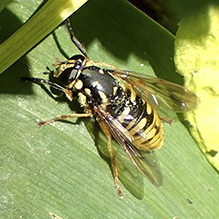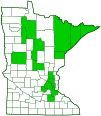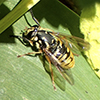wasp-like falsehorn
(Temnostoma alternans)
Conservation • Description • Habitat • Ecology • Distribution • Taxonomy
|
|
||||||||||||||
Description |
Wasp-like falsehorn is a medium-sized to large, wasp-mimic hoverfly. In the United States, it occurs in the east from Maine to New Jersey, west to Minnesota and Ohio, and south along the Appalachian Mountains to Tennessee. It also occurs in the Pacific Northwest and across southern Canada. Wasp-like falsehorn adults are active from May through July. They are found mostly in dense hardwood forests and damp woodlands, but also in spruce forests and fens. The larvae bore into the moist, decaying wood of fallen logs. Adults are 7⁄16″ to ⅝″ (10.5 to 16.5 mm) in length. The body is relatively bare and black with yellow markings. The markings resemble yellowjacket queens. The head is hemispherical and slightly broader than the thorax. There are two large compound eyes on the sides of the head and three small simple eyes (ocelli) in a triangle on top of the head. The compound eyes are dark brown and bare, not covered with hair. On the male they meet at the top of the head. On the female they do not. The antennae are short, they have three segments, and they are inserted in the middle of the head. The third segment is round or almost round. At the base of the third segment there is a long, forward-pointing bristle (arista) on the upper side. The arista is bare, not feather-like (plumose). The face is not strongly extended downward. The protruding mouthpart (proboscis) is short and fleshy. The thorax is black with several yellow markings. It is relatively long and has three segments. Each segment has four principal exoskeletal plates, one above, one below, and one on each side. The upper (dorsal) plates, from front to rear, are the prescutum, scutum, and scutellum. There is a yellow spot at each front corner of the prescutum. There is a groove (transverse suture) across the scutum near the middle just before the wing bases. There are two yellow spots on the transverse suture. There is a small triangular mark at the rear of the scutum immediately above the scutellum. The scutellum is black and is covered with yellow hairs. The plate on the underside of the second thoracic segment (katepisternum) has a continuous (uninterrupted) band of hairs on the rear margin. This feature differentiates Temnostoma from other large wasp-mimic genera. On the abdomen, the second, third, and fourth segments (tergites) each have 2 yellow bands. On the fourth tergite, there are three black spots between the two bands. The wings are mostly clear with a variable amount of dark shading along the veins. There is a false vein (spurious vein) between the radius (R) and media (M) veins. The outer (anterior) cross-vein that runs between the radius and media veins (R-M cross-vein) does so near the middle of the discal cell. The anal cell is long and is closed near the wing margin. The R5 and M2 cells are also closed. The third segment (femur) on each leg is black on the basal half, yellow on the outer half. On the front legs, the fourth segment (tibia), and the last part of the leg (tarsus) corresponding to the foot, are black. On the middle and hind legs, they are yellow. |
Size |
Total length: 7⁄16″ to ⅝″ (10.5 to 16.5 mm) |
Similar Species |
Habitat |
Dense deciduous forests, damp woodlands, spruce forests, and fens |
Ecology |
Season |
May through July |
Behavior |
Males engage in “hilltopping” to find a mate. In the morning, they fly to the most prominent hilltop, or in a flat area to a low rise. Hilltopping behavior ends soon after noon. Adults have short antennae, but they will mimic wasps by extending and vibrating their front legs. |
Life Cycle |
|
Larva Food |
Decaying organic debris |
Adult Food |
Flower nectar |
Distribution |
||
|
Sources Telford, Horace S.. (1939). The Syrphidae of Minnesota. University of Minnesota. Minnesota Agricultural Experiment Station. |
|
| 4/16/2024 | ||
Occurrence |
||
Common |
||
Taxonomy |
|
Order |
|
Suborder |
Brachycera |
Infraorder |
Cyclorrhapha |
Zoosection |
Aschiza |
Family |
Syrphidae (Hover Flies) |
Subfamily |
Eristalinae (Drone Flies and Allies) |
Tribe |
Milesiini |
Subtribe |
Temnostomina |
Genus |
Temnostoma (falsehorn flies) |
Subordinate Taxa |
|
|
|
Synonyms |
|
|
|
Common Names |
|
wasp-like falsehorn |
|
Glossary
Femur
On insects and arachnids, the third, largest, most robust segment of the leg, coming immediately before the tibia. On humans, the thigh bone.
Ocellus
Simple eye; an eye with a single lens. Plural: ocelli.
Proboscis
The tube-like protruding mouthpart(s) of a sucking insect.
Scutellum
The exoskeletal plate covering the rearward (posterior) part of the middle segment of the thorax in some insects. In Coleoptera, Hemiptera, and Homoptera, the dorsal, often triangular plate behind the pronotum and between the bases of the front wings. In Diptera, the exoskeletal plate between the abdomen and the thorax.
Scutum
The forward (anterior) portion of the middle segment of the thorax (mesonotum) in insects and some arachnids.
Tarsus
On insects, the last two to five subdivisions of the leg, attached to the tibia; the foot. On spiders, the last segment of the leg. Plural: tarsi.
Tergite
The upper (dorsal), hardened plate on a segment of the thorax or abdomen of an arthropod or myriapod.
Tibia
The fourth segment of an insect leg, after the femur and before the tarsus (foot). The fifth segment of a spider leg or palp. Plural: tibiae.
Visitor Photos |
||
Share your photo of this insect. |
||
This button not working for you? |
||
Babette Kis |
||
Temnostoma alternans wasp-like bee fly Temnostoma alternans, wasp-like bee fly, hedgerow next to Barnes Prairie, Racine Co., WI. Photo was taken June 12, 2020. I rarely see these large bee flies, and when I do, they have always been near shady areas adjacent to fields, or in this case, flowers at Barnes Prairie. |
||
MinnesotaSeasons.com Photos |
||
|
||
|
||

Slideshows |
|

Visitor Videos |
||
Share your video of this insect. |
||
This button not working for you? |
||
|
Other Videos |
||
Wasp-like Falsehorn (Temnostoma alternans) cleaning face |
About
Jul 20, 2019 For iNaturalist observation: https://inaturalist.ca/observations/29205459 |

Visitor Sightings |
||
Report a sighting of this insect. |
||
This button not working for you? |
||
MinnesotaSeasons.com Sightings |
||
|

|
Created: 4/16/2024 Last Updated: © MinnesotaSeasons.com. All rights reserved. |


